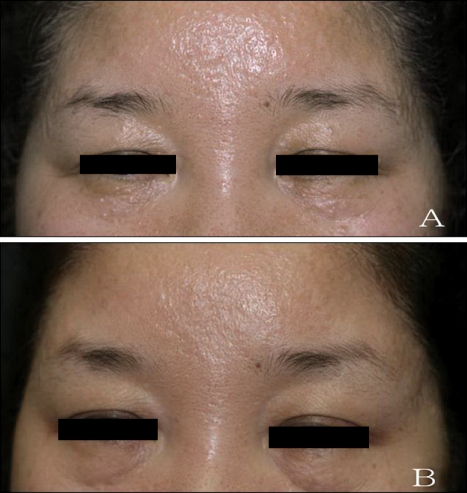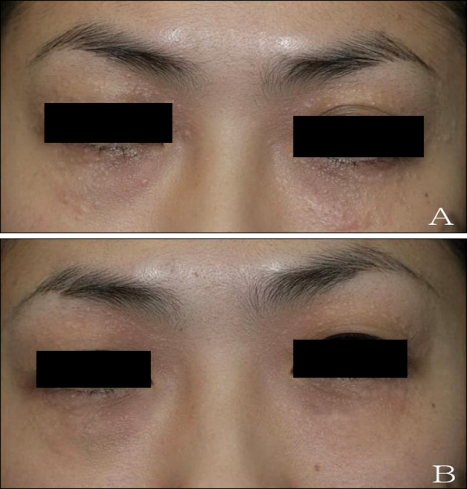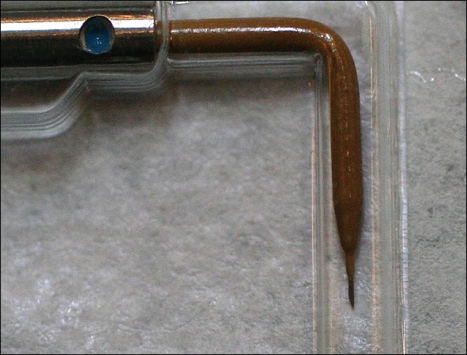Abstract
Syringoma is a benign adnexal tumor derived from intradermal eccrine ducts; it predominantly occurs in women at puberty or later in life. Although syringoma is a common benign neoplasm, there have been no effective therapies for its removal. Conventional therapies for syringomas, including surgical excision, electrodessication, chemical peeling, topical atropine or tretinoin, cryosurgery, and laser therapy, can lead to cosmetic defects such as hyperpigmentation or scarring due to epidermal damage. In contrast, treatment using intralesional insulated needles, which are insulated at the point of epidermal contact, has been shown to result in good cosmetic outcomes due to selective destruction of dermal lesions. This could be an effective and highly satisfying treatment for syringomas. We herein present 2 patients with syringomas treated with intralesional insulated needles.
Keywords: Insulated needle, Syringoma
INTRODUCTION
Syringoma is a common tumor of eccrine origin1. Performing a complete excision of syringoma with only minimal adverse side effects is very difficult. The conventional treatment options for syringomas include surgical excision, electrodesiccation, chemical peelings, topical atropine or tretinoin, cryotherapy, and laser therapy2. These have potential problems such as postinflammatory hyperpigmentation, low efficacy or scar formation. We present 2 patients with syringomas treated by intralesional insulated needles, which allowed selective destruction of dermal lesions without epidermal damage.
CASE REPORT
Two women, 54 and 27 years of age, presented with skin-colored or yellowish tiny papules on their periorbital areas and forehead (Figs. 1, 2). The skin lesions of the older patient were diagnosed histopathologically as syringoma, while the other patient was diagnosed clinically with syringoma. They had been previously treated with several sessions of CO2 laser ablation and cryotherapy, but the lesions were refractory to these methods and repeatedly recurred. In addition, adverse effects such as postinflammatory hyperpigmentation and atrophic scarring appeared after the treatment modalities.
Fig. 1.
(A) A 54-year-old woman had skin-colored or yellowish tiny papules on her periorbital areas and forehead. (B) After 8 sessions of treatment, there was a marked reduction in the size and number of lesions without adverse effects.
Fig. 2.
(A) A 27-year-old woman had skin-colored or yellowish tiny papules on her periorbital areas. (B) The treatment showed good efficacy without adverse effects after 3 sessions.
As a result, we decided to use intralesional insulated needles to improve the cosmetic outcome. We used K-type needles that could selectively destroy intradermal target lesions without leaving scars due to insulation of their epidermal point of contact (Fig. 3). Insulated needles were connected to the HR 5000 electrocoagulator® (IME Co., Ltd.). The needles were then inserted into each lesion, and a high frequency current was applied to the needles for 1 second with the output dial set at 8 (corresponding to approximately 40 W). The interval times between sessions were 2 to 3 weeks. Assessments of clinical improvement were performed by 3 dermatologists, who identified the reduction in size and number of the treated lesions. Clinical improvement was also based on the subjective satisfaction of the patients using a visual analogue scale (VAS, 0~7, 0: not at all satisfied, 7: very satisfied). The older patient underwent 8 sessions, while the other patient had 3 sessions. Both patients demonstrated a marked reduction in the size and number of their lesions (Figs. 1, 2) and had high satisfaction (VAS score, 6). Other than transient, mild erythema and pain, they had no adverse effects such as scarring and hyperpigmentation related to epidermal damage. Since the last treatment session 6 months ago, the lesions have not recurred.
Fig. 3.
K-type needles that can selectively destroy intradermal target lesions without scarring due to insulation of epidermal point of contact.
DISCUSSION
Syringomas are benign adnexal neoplasms that show eccrine ductal differentiation. They are more common in women than men and represent one of the most common benign neoplasms of the skin. Clinically, syringomas appear as small yellowish or skin-colored papules that are often located on the periorbital areas1. Most syringomas involve the facial area, so the cosmetic outcome is important.
There are various treatment options for syringomas, including surgical excision, topical atropine or tretinoin applications, cryosurgery, electrodesiccation, chemical peelings, and laser ablation. However, these methods often have cosmetic disadvantages, such as scarring, deformity, changes in pigmentation, and a low rate of cure2. Recently, new treatments such as Q-switched Nd:YAG laser treatment after temporary tattooing of the lesions or the multiple drilling method with super-pulse-mode CO2 laser were introduced3, but the cosmetic problems from epidermal injury and low efficacy rate due to incomplete destruction of deep dermal lesions were not much improved. The ideal treatment strategy for syringomas is selective destruction of dermal target lesions with little damage to normal epidermal tissue. As a result, we tried to treat patients with intralesional insulated needles.
Intralesional insulated needles have been used for epilation4 and the treatment of telangiectasia5 and axillary hyperhidrosis6. In previous studies, Karam and Benedetto7 used these needles in the treatment of syringomas and reported good results. We used a type of needle that had insulation on its base, while its shaft and tip were not insulated (Fig. 3). That way, the needle could selectively destroy dermal or subcutaneous tissue without damage to the skin surface. The insulated needle was connected to the HR 5000 electrocoagulator® (IME Co., Ltd.), which transferred high frequency current to the needle while preserving needle insulation8. We set the output dial at 8, corresponding to 40 W. This setting resulted in satisfactory tissue coagulation.
After treatment with intralesional insulated needles, both patients showed a marked reduction in the size and number of the lesions (Figs. 1, 2). In addition to its efficacy, the cosmetic outcomes from the needles were excellent. No erythema, pigmentation, and scarring were observed. Because of the good clinical efficacy and cosmetic outcome, the patients were very satisfied with this method. However, due to the necessity of injecting each individual lesion, each session took a long time. Also, multiple sessions were required to get a good result.
In conclusion, treatment of syringomas with intralesional insulated needles was easy, safe, and effective. Furthermore, excellent cosmetic outcomes encourage us to use this method for facial lesions. Further study with larger numbers of patients would be necessary for assessment of the long-term outcome, proper setting of power and possible reduction of time and number of treatment sessions.
References
- 1.Obaidat NA, Alsaad KO, Ghazarian D. Skin adnexal neoplasms--part 2: an approach to tumours of cutaneous sweat glands. J Clin Pathol. 2007;60:145–159. doi: 10.1136/jcp.2006.041608. [DOI] [PMC free article] [PubMed] [Google Scholar]
- 2.Al Aradi IK. Periorbital syringoma: a pilot study of the efficacy of low-voltage electrocoagulation. Dermatol Surg. 2006;32:1244–1250. doi: 10.1111/j.1524-4725.2006.32284.x. [DOI] [PubMed] [Google Scholar]
- 3.Park HJ, Lee DY, Lee JH, Yang JM, Lee ES, Kim WS. The treatment of syringomas by CO2 laser using a multiple-drilling method. Dermatol Surg. 2007;33:310–313. doi: 10.1111/j.1524-4725.2007.33065.x. [DOI] [PubMed] [Google Scholar]
- 4.Kobayashi T. Electrosurgery using insulated needles: epilation. J Dermatol Surg Oncol. 1985;11:993–1000. doi: 10.1111/j.1524-4725.1985.tb01383.x. [DOI] [PubMed] [Google Scholar]
- 5.Kobayashi T. Electrosurgery using insulated needles: treatment of telangiectasias. J Dermatol Surg Oncol. 1986;12:936–942. doi: 10.1111/j.1524-4725.1986.tb02135.x. [DOI] [PubMed] [Google Scholar]
- 6.Kobayashi T. Electrosurgery using insulated needles: treatment of axillary bromhidrosis and hyperhidrosis. J Dermatol Surg Oncol. 1988;14:749–752. doi: 10.1111/j.1524-4725.1988.tb01159.x. [DOI] [PubMed] [Google Scholar]
- 7.Karam P, Benedetto AV. Intralesional electrodesiccation of syringomas. Dermatol Surg. 1997;23:921–924. doi: 10.1111/j.1524-4725.1997.tb00749.x. [DOI] [PubMed] [Google Scholar]
- 8.Kobayashi T, Yamada S. Electrosurgery using insulated needles: basic studies. J Dermatol Surg Oncol. 1987;13:1081–1084. doi: 10.1111/j.1524-4725.1987.tb00914.x. [DOI] [PubMed] [Google Scholar]





